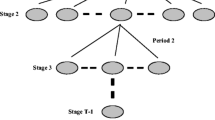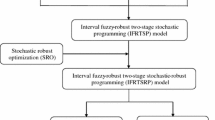Abstract
In this study, an inexact fuzzy-robust two-stage programming (IFRTSP) method is developed for tackling multiple forms of uncertainties that can be expressed as discrete intervals, probabilistic distributions and/or fuzzy membership functions. The model can reflect economic penalties of corrective measures against any infeasibilities arising due to a particular realization of system uncertainties. Moreover, the fuzzy decision space can be delimited into a more robust one with the uncertainties being specified through dimensional enlargement of the original fuzzy constraints. A management problem in terms of regional air pollution control has been studied to illustrate the applicability of the proposed approach. Results indicate that useful solutions for planning the air quality management practices have been generated. They can help decision makers identify desired pollution-abatement strategy with minimized system cost and maximized environmental efficiency.



Similar content being viewed by others
References
Ahmed, S. (2000). Strategic planning under uncertainty: stochastic integer programming approaches. PhD thesis, University of Illinois, Urbana, IL, 2000.
Ahmed, S., & Sahinidis, N. V. (2003). An approximation scheme for two-stage stochastic integer programs arising in capacity expansion. Operations Research, 51(3), 461–471.
Ben-Tal, A., & Nemirovski, A. (1999). Robust solutions to uncertain linear programs. Operational Research Letters, 25, 1–13.
Ben-Tal, A., & Nemirovski, A. (2002). Robust optimization – methodology and applications. Mathematical Programing, Series B, 92, 453–480.
Birge, J. R., & Louveaux, F. V. (1988). A multicut algorithm for two-stage stochastic linear programs. European Journal of Operational Research, 34, 384–392.
Birge, J. R., & Louveaux, F. V. (1997). Introduction to stochastic programming. New York, NY: Springer.
Dantzig, G. B. (1983). Reminiscences about the origins of linear programming. In Bachem, Grostschel, & Korte (Eds.), Mathematical programming: The state of the art. Berlin: Springer Verlag.
de Nevers, N. (2000). Air pollution control engineering (2nd ed.). McGraw-Hill Companies, Inc.
Dubois, D., & Prade, H. (1978). Operations on fuzzy number. International Journal of Systems Science, 9, 613–626.
Dubois, D., & Prade, H. (1988). Possibility theory – an approach to the computerized processing of uncertainty. New York: Plenum Press.
Ellis, J. H., & Bowman, M. L. (1994). Critical loads and development of acid rain control options. ASCE Journal of Environmental Engineering, 120(2), 273–290.
Ellis, J. H., McBean, E. A., & Farquhar, G. J. (1985) Chance-constrained stochastic linear programming model for acid rain abatement – I. Complete colinearity and noncolinearity. Atmospheric Environment, 19, 925–937.
Ellis, J. H., McBean, E. A., & Farquhar, G. J. (1986). Chance-constrained stochastic linear programming model for acid rain abatement – II. Limited colinearity. Atmospheric Environment, 20, 501–511.
Flagan, R. C., & Seinfeld, J. H. (1988). Fundamentals of air pollution engineering. Englewood Cliffs, NJ: Prentice-Hall.
Guldmann, J.-M. (1986). Interactions between weather stochasticity and the locations of pollution sources and receptors in air quality planning: a chance-constrained approach. Geographical Analysis, 18(3), 198–214.
Guldman, J.-M. (1988). Chance-constrained dynamic model of air quality management. Fuzzy Sets and Systems, 114(5), 1116–1126.
Hailth, A. D. (1982). Environmental systems optimization. New York: Wiley.
Haurie, A., Kübler, J. J. E., Clappier, A., & Bergh van den, H. (2004). A Metamodeling approach for integrated assessment of air quality policies. Environmental Modeling and Assessment, 9, 1–12.
Huang, G. H., Baetz, B. W., & Patry, G. G. (1992). An interval linear programming approach for municipal solid waste management planning under uncertainty. Civil Engineering Systems, 9, 319–335.
Huang, G. H., & Loucks, D. P. (2000). An inexact two-stage stochastic programming model for water resources management under uncertainty. Civil Engineering and Environmental Systems, 17, 95–118.
Inuiguchi, M., & Sakawa, M. (1994). Possible and necessary optimality tests in possibilistic linear programming problems. Fuzzy Sets and Systems, 67, 29–46.
Inuiguchi, M., & Sakawa, M. (1998). Robust optimization under softness in a fuzzy linear programming problem. International Journal of Approximate Reasoning, 18, 21–34.
Karatzas, K. D. (2002). Theoretical investigation of urban air quality management systems performance towards simplified strategic environmental planning. Water, Air, and Soil Pollution: Focus, 2, 669–676.
Kovacs, L., Boros, E., & Inotay, F. (1986). A two-stage approach for large-scale sewer systems design with application to the Lake Balaton resort area. European Journal of Operational Research 23(2), 169–178.
Kumar, A. (1977). Pollutant dispersion in the planetary boundary layer. PhD thesis, University of Waterloo.
Kumar, A., & Djurfors, S. G. (1978). Maximum and critical ground level concentrations from a synthetic crude oil plant. Proceedings of 1978 Annual Meeting of the Air Pollution Control Association, Houston, TX.
Lejano, R. P., Ayala, P. M., & Gonzales, E. A. (1997). Optimizing the mix of strategies for control of vehicular emissions. Environmental Management, 21(1), 79–87.
Leung, Y. (1988). Spatial analysis and planning under imprecision (Studies in Regional Science and Urban Economics). Amsterdam, the Netherlands: Elsevier.
Liu, L., Huang, G. H., Liu, Y., & Fuller, G. A. (2003). A fuzzy-stochastic robust programming model for regional air quality management under uncertainty. Engineering Optimization, 35(2), 177–199.
Loucks, D. P., Stedinger, J. R., & Haith, D. A. (1981). Water resource systems planning and analysis. Englewood Cliffs, NJ: Prentice-Hall.
Luhandjula, M. K., & Gupta, M. M. (1996). On fuzzy stochastic optimization. Fuzzy Sets and Systems, 81, 47–55.
Macchiato, M. F., Cosmi, C., Ragosta, M., Tosato, G. (1994). Atmospheric emission reduction and abatement costs in regional environmental planning. Journal of Environmental Management, 41, 141–156.
Maqsood, I., & Huang, G. H. (2003). A two-stage interval-stochastic programming model for waste management under uncertainty. Journal of the Air & Waste Management Association, 53(5), 540–552.
Negoita, C. V., Minoiu, S., & Stan, E. (1976). On considering imprecision in dynamic linear programming. Economic Computation and Economic Cybernetics Studies and Research, 3, 83–96.
Nie, X. H., Huang, G. H., Liu, L., & Li, Y. P. (2006). IFRP: a hybrid interval-parameter fuzzy robust programming approach for municipal solid waste management planning under uncertainty. Journal of Environmental Management, Available online in July.
Pereira, M. V. F., & Pinto, L. M. V. G. (1985). Stochastic optimization of a multireservior hydroelectric system: a decomposition approach. Water Resources Research, 6, 779–792.
Seifi, A., & Hipel, K. W. (2001). Interior-point method for reservoir operation with stochastic inflows. ASCE – Journal of Water Resources Planning and Management, 127(1), 48–57.
Singpurwalla, N. D. (1975). Models in air pollution, Chapter 3 in Gass and Sisson, 66–102.
Soyster, A. L. (1973). Convex programming with set-inclusive constraints: applications to inexact linear programming. Operations Research, 21, 1154–1157.
Teller, A. (1968). The use of linear programming to estimate the cost of some alternatives air pollution abatement policies. Number 20 in IBM, 345–353.
Teng, J., & Tzeng, G. (1994). Multicriteria evaluation for strategies of improving and controlling air quality in the super city: a case study of Taipei City. Journal of Environmental Management, 40, 213–229.
USEPA (United States Environmental Protection Agency), SO2 Allowance Market Analysis (2004). Update, Washington.
Wang, D., & Adams, B. J. (1986). Optimization of real-time reservoir operations with Markov decision processes. Water Resources Research, 22, 345–352.
Wark, K., Warner, C. F., & Davis, W. T. (1998). Air pollution: Its origin and control (3rd Edition). New York: Harper Collins.
Werczberger, E. (1974). A mixed-integer programming model for the integration of air quality policy into land-use planning. Papers in Regional Science Association, 33, 141–154.
WHO (2000). Guidelines for air quality. Geneva, Switzerland: World Health Organization.
Zolezzi, T. (2001). Well-posedness and optimization under perturbations. Annals of Operations Research, 101(1), 351–361.
Acknowledgement
This research has been supported by the Major State Basic Research Development Program of China (2005CB724201 and 2005CB724207) and the Natural Science and Engineering Research Council of Canada. The authors are grateful to the editors and the anonymous reviewers for their insightful comments and suggestions.
Author information
Authors and Affiliations
Corresponding author
Rights and permissions
About this article
Cite this article
Li, Y.P., Huang, G.H., Nie, X.H. et al. An Inexact Fuzzy-robust Two-stage Programming Model for Managing Sulfur Dioxide Abatement Under Uncertainty. Environ Model Assess 13, 77–91 (2008). https://doi.org/10.1007/s10666-006-9077-z
Received:
Accepted:
Published:
Issue Date:
DOI: https://doi.org/10.1007/s10666-006-9077-z




